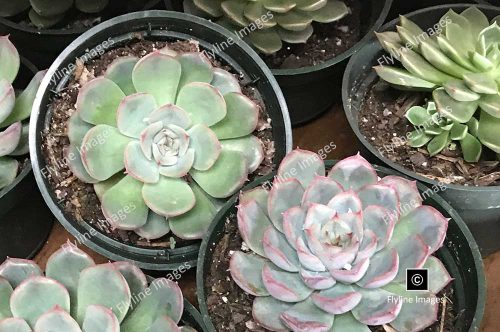Succulents
Aloe, Cacti, Echeveria, Jade Plants and More
Succulents are a diverse group of plants known for their ability to store water in thick, fleshy leaves or stems, which makes them well-suited for arid environments. This group includes popular varieties like cacti, aloe, echeveria, and jade plants. People love succulents for several reasons. Firstly, their low maintenance needs and resilience make them an ideal choice for busy individuals or those new to gardening. Secondly, their unique and diverse shapes, sizes, and colors add aesthetic value to homes and offices. Additionally, succulents are easy to propagate, allowing enthusiasts to expand their collection effortlessly. Finally, succulents are said to improve indoor air quality, contributing to a healthier living environment.
Portrait Style Images
 MORE ABOUT SUCCULENT PLANTS
MORE ABOUT SUCCULENT PLANTS
Succulent plants are fascinating and resilient species known for their ability to thrive in arid environments due to their unique water-retention capabilities. These plants are characterized by thick, fleshy leaves or stems that store water, allowing them to survive prolonged periods of drought. Commonly found in desert regions, succulents come in a variety of shapes, sizes, and colors, making them popular among plant enthusiasts and gardeners. Some well-known types of succulents include aloe vera, jade plant, and various species of cacti. These plants are not only visually appealing but also relatively easy to care for, requiring minimal watering and thriving in well-draining soil. Moreover, succulents have medicinal and therapeutic properties, with some varieties being used in skincare and holistic medicine. Their ability to flourish in harsh conditions makes succulents a symbol of endurance and adaptability in the plant world.
Succulents have a long history, with evidence of their existence dating back millions of years. Fossil records show that these plants first appeared in arid regions during the late Cretaceous period and have since evolved to survive in diverse climates and conditions. One of the key adaptations that enabled succulents to thrive in dry environments is their unique leaf structure. Unlike other plants, succulent leaves are covered in a waxy coating or hairs, which helps prevent water loss through evaporation.
In addition to their natural resilience, succulents also have cultural significance and symbolism. In many ancient civilizations, such as Egypt and Rome, succulents were believed to possess healing properties and were used in traditional medicine. They were also associated with gods and goddesses, representing longevity, prosperity, and fertility. Today, succulents continue to hold a special place in various cultures and traditions, with some varieties being used in religious ceremonies or as decorative elements in festivities.
The popularity of succulents has increased significantly in recent years, with these plants becoming a staple in interior design, wedding decor, and social media trends. Their low maintenance and aesthetic appeal make them an ideal choice for those looking to add greenery to their homes or gardens. Furthermore, the rise of sustainability practices has led to a growing interest in drought-resistant plants like succulents, as they require less water compared to traditional garden plants.
SUCCULENTS THRIVE IN PARTS OF NORTH AMERICA
Succulent plants can thrive in a wide range of climates, but they are predominantly found in regions with arid conditions. In the United States, the states with the most abundant succulent plant growth are largely in the Southwest, particularly Arizona, California, New Mexico, and Texas. These areas provide the ideal dry, sunny environments that succulents require. California, in particular, is home to a diverse array of succulents due to its varied climate zones, ranging from coastal to desert conditions. Additionally, the desert regions of Nevada and Utah also host numerous native succulent species, adding to the rich biodiversity of this plant type in the western United States.
Succulents are also found in other parts of the world, including Africa, South America, and Asia. In these regions, succulent plants have adapted to thrive in harsh environments with limited water availability. This ability to survive in extreme conditions has made succulents popular among gardeners and plant enthusiasts worldwide.
Succulent plants come in a wide variety of shapes, sizes, colors, and textures. Some common types include cacti, agaves, aloes, and sedums. Each type has unique characteristics that make them visually appealing and suitable for different growing conditions.
One of the most notable traits of succulents is their ability to store water in their leaves or stems. This adaptation allows them to survive for long periods without water, making them ideal plants for xeriscaping and low-water gardens. Additionally, their thick fleshy leaves also make them resistant to pests and diseases, making them relatively easy to care for.











